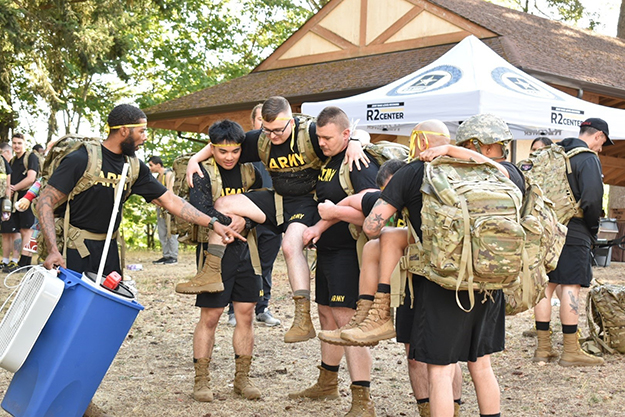JOINT BASE LEWIS-McCHORD - Stress is an everyday occurrence for most people, especially active-duty service members. Whether it be family, work or financial stressors, finding a way to cope with the mental weight of stress and any additional duties can be hard for just about everyone. But very few people ever open up to others about the burdens they carry every day, and, in the worst-case scenario, that can have devastating consequences.
On Sept. 6, service members across Joint Base Lewis-McChord took a stand to put an end to the stigma surrounding mental health awareness and learned how to be there for each other during the Fill the Ruck 5K event at Shoreline Park on Lewis North.
"Fill the Ruck started with an idea of how to start the conversations about what leads to suicide," said Jackie Salazar, the event's organizer, and manager of the Army Substance Abuse Program (ASAP) at JBLM. "Suicide is a complex issue that can come from a combination of factors. We wanted to stress to service members the importance of seeking help from professionals and supportive individuals who can provide guidance and give them the resources available on and off the installation.?We also wanted to stress the importance of communication and getting to know the person to the left and right of you and knowing their baseline."
From that thought process, the Fill the Ruck event was born. Symbolizing the everyday stress that a person carries with them, squads of service members set off on a march just over three miles long from Shoreline Park to Russell Landing and back. Each squad member carried a 30-pound ruck bag on their backs - their baseline, or everyday stress - and, as a group, they carried two, large rocks meant to represent added stress.
"The rocks were meant to signify that we all have other stress than our normal baseline, and this is why we should ask for help when needed, or let people know when we are struggling with something," Salazar said.
Along the march, the squads encountered three stations with activities requiring communication and teamwork to complete together as a group. The first was a twist on the game "telephone" and had each squad member relaying information from one to another with the goal of getting the information accurately transferred through the entire group. The second, required one squad member to put puzzles together while blindfolded, using only the guidance from his squad members.
The third and final station allowed teams to paint the rocks they had carried with them along the march. Each team member was required to add their own touch to the rocks about the power of positivity and resiliency. Salazar said this was by far the most popular part of the event.
"I had an overwhelming amount of soldiers tell me that they really loved the painting of the rocks part the most, and that really touched me," she said. "We intended for the squads to leave the rocks and a member of our ASAP team would deliver it to their command after the event, but we found that a good number of squads actually took their rocks with them. That makes us all feel really happy because to us, it feels like those rocks now mean something to them about what they did here today."
Sergeant Cameron Mims, with the 2nd Brigade Support Battalion, 2nd Brigade, 2nd Infantry Division, said he was surprised at how interactive the event was, and that he was able to take away more than he expected.
"We had a lot of fun doing this, but it was also really useful," Mims said. "I learned a lot today about communication and teamwork, and just overall how to be a better teammate."
Immediately after teams returned from the ruck march portion of the event, Salazar said the groups are then ushered to other stations where they have the teams talk about situations regarding financial or relationship problems, and how they could work through those issues safely.
"Financial and relationships are the top two factors of suicide we have identified here at JBLM," Salazar said.
More than 100 squads at JBLM were represented at the event, with about 1,800 total service members participating. Salazar said it was so well received by participants that she believes it could become an annual event.





Read Comments